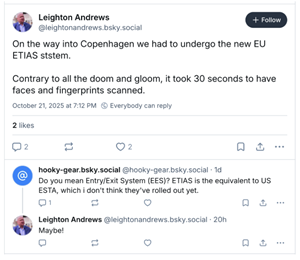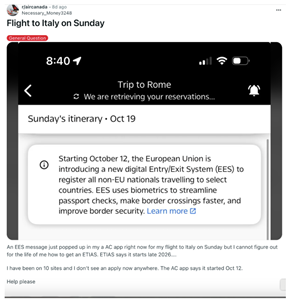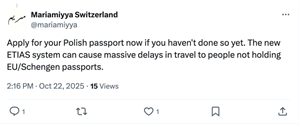Travelers Seek Answers as ETIAS Timeline Remains Uncertain: When Will It Finally Launch?
As 149 million travelers plan Europe trips, iVisa’s analysis shows rising confusion surrounding the European Travel Information and Authorisation System.
Miami, Florida, Nov. 18, 2025 (GLOBE NEWSWIRE) -- Europe’s long-awaited ETIAS travel authorization has been “coming soon” for nearly 7 years. Announced in 2018 and delayed multiple times, the program, designed to strengthen border security and streamline entry for travelers from visa-exempt countries still doesn’t have a confirmed ETIAS launch date.
Since its introduction, the rollout timeline has been repeatedly pushed back: first to 2022, then to 2024, and most recently to the final quarter of 2026.
Officials attribute the repeated postponements to the complexity of integrating multiple EU databases, testing infrastructure, and coordinating policies across 30 member and associated countries.

Across social media platforms such as Facebook, X (formerly Twitter), Reddit, and travel blogs, travelers continue to trade rumors:
- “When will ETIAS start?”
- “How much will ETIAS cost?”
The repeated delays have left even frequent fliers familiar with systems like the U.S. ESTA or the U.K. ETA feeling uncertain about what to expect.
Part of the confusion stems from conflicting, outdated, or unverified online information. Many travelers overlook the publication dates of articles or rely on unofficial websites that have not been updated since earlier ETIAS announcements.
“Rolling out ETIAS is a massive undertaking,” says Sabrina Capriles, Travel Documentation Specialist at iVisa. “Unlike the U.S. or U.K., this isn’t one country changing how it manages borders – it’s thirty. Linking that many systems under a single platform is no small feat, so delays are hardly surprising.”
The real challenge now is managing expectations, keeping travelers informed and confident, while avoiding unnecessary confusion.
How ETIAS will change travel for millions entering Europe
Once launched, ETIAS will require visa-exempt citizens from 59 countries, including the United States, Canada, Australia, and Japan, to complete an online authorization before visiting 30 European destinations.
The ETIAS system will apply to short trips of up to 90 days within any 180 days. Travelers will provide basic personal details, passport information, and pay a small fee. Most approvals are expected to be processed quickly and remain valid for three years, or until the traveler’s passport expires.
In practice, ETIAS will function much like the US ESTA or the Canada and UK ETAs, not a visa, but a pre-travel clearance designed to make Europe’s borders smarter, safer, and more efficient.
Why ETIAS is confusing travelers
ETIAS may seem simple on paper, but iVisa’s 2024/2025 social listening analysis across X, Reddit, Meta, and travel blogs shows that confusion remains the dominant theme in traveler discussions. While many are eager to understand how the system will work, much of the online conversation reveals uncertainty, misinformation, and mixed expectations.
iVisa’s analysis found four recurring patterns in how travelers are talking about ETIAS:
1. Travelers who have experienced the system (or think they have):
Leighton Andrews wrote on Bluesky:
While other users comment in Reddit:

2. Travelers who think ETIAS will bring more trouble and delays on X: 
3. Travelers who advise other travelers about dates and how it works, creating more confusion:
A good example of this is a comment left on a travel blog post by James H stating:

4. Travelers who are anxious that ETIAS will launch before their trip:
One Facebook user, Susan Reed, wrote:
“These online sentiments show that travelers are interested – but confused,” says Maritza Gardner, iVisa’s UGC Content Researcher. “The good news is that once the European Commission confirms the start date and official channels, clarity will follow quickly if a good communication plan is implemented.”
The Price and the Perception
The EU initially intended the ETIAS to cost €7, but as the system developed, it became clear that the actual cost could be higher due to administrative expenses. In fact, according to a recent update from the European Commission's Directorate-General for Migration and Home Affairs, it is not expected to increase to €20.
While the amount isn’t as high as a traditional Schengen visa, the surrounding uncertainty has symbolic weight for many travelers; it represents one more digital step in an already complex journey.
Once fully implemented, the system is projected to process tens of millions of travelers annually, with the generated fees supporting the ongoing maintenance of border infrastructure, system operations, and data security initiatives. According to Google Flights data, between January 1 and November 1, 2025, there were over 149 million flight searches to ETIAS-required destinations from eligible countries.
Travelers looked for flights an average of 74 days before departure, with typical trip durations of around 8.5 days – a clear indication of the massive travel flow that will soon fall under the ETIAS framework.
Lessons From Other Systems
ETIAS is not the first electronic travel authorization to face skepticism before launch. When the U.S. rolled out ESTA in 2009, travelers were unsure how it differed from a visa.
Canada’s eTA and the UK’s ETA encountered similar early confusion, yet within months, adoption became routine and compliance near universal.
The same outcome is likely here. ETIAS is expected to quickly normalize once travelers experience how fast and straightforward it is.
What Travelers Should Do Now
-
Follow official sources. Until the ETIAS launch date is confirmed, rely only on verified EU announcements and trusted platforms, such as iVisa, for updates.
-
Prepare in advance. Once live, complete your ETIAS application several days before departure to avoid any last-minute stress.
-
Keep perspective. ETIAS is a preventive measure designed to protect travelers and borders alike, not a barrier to visiting Europe. It’s still a straightforward process that won’t require a visit to an embassy or extensive documentation (excluding bank statements, proof of accommodation, invitation letters, and similar documents).
-
Regarding rejections: Although not yet widely discussed, travelers should be aware that an ETIAS application can be refused. In such cases, the traveler may need to apply for a regular Schengen visa instead, even if they come from a visa-waiver country.
Attachments
- ETIAS Europe Visa waiver timeline
- Bluesky ETIAS vs EES confusion comment
- Facebook ETIAS comment
- Reddit ETIAS vs EES confusion
- Travel blog thread on ETIAS
- X ETIAS comment

Paula Voto Bernales iVisa paula.votobernales@ivisa.com
ETIAS Europe Visa waiver timeline
iVisa ETIAS Launch Timeline from 2018 to 2026
Bluesky ETIAS vs EES confusion comment
Social Media Bluesky EU ETIAS vs EES user's comment
Facebook ETIAS comment
Social Media Facebook ETIAS comment showing sentiment about the implementation
Reddit ETIAS vs EES confusion
Reddit ETIAS Thread dates confusion vs EES
Travel blog thread on ETIAS
Comment on a travel blog showing confusion on ETIAS
X ETIAS comment
Screenshot of a traveler's comment on X Social Media showing concerns on ETIAS implementation.
Legal Disclaimer:
EIN Presswire provides this news content "as is" without warranty of any kind. We do not accept any responsibility or liability for the accuracy, content, images, videos, licenses, completeness, legality, or reliability of the information contained in this article. If you have any complaints or copyright issues related to this article, kindly contact the author above.






